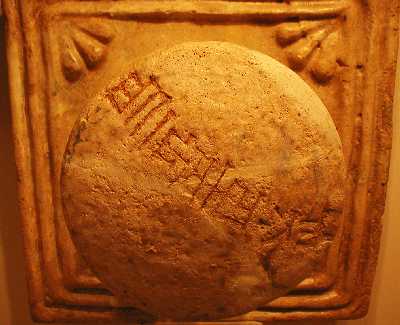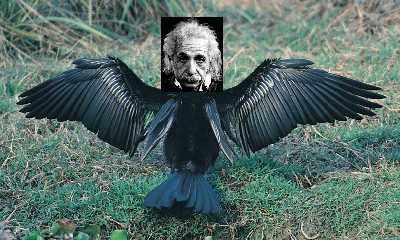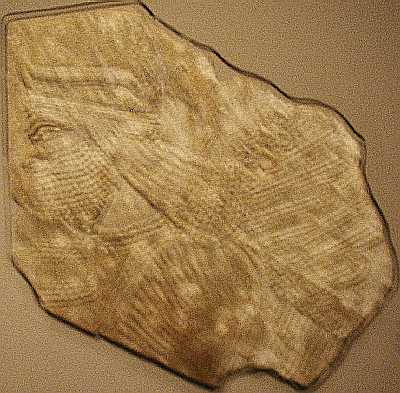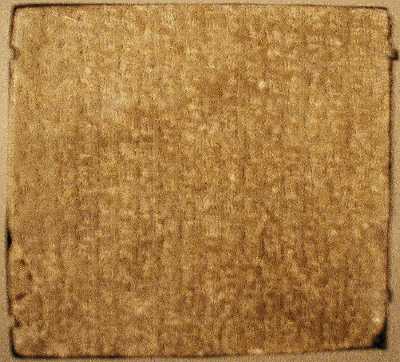Continuing where I left off in last week's blog, the same West Asia room at the Cincinnati Art Museum (CAM) had this on display:

The placard says it's royal, but it would've been nice to have a letter-by-letter transliteration:
Knobbed plaque with royal
inscription of Untash-Gal
Southwestern Iran, Elamite; excavated at
Tchoga Zanbil
around 1250BC
glazed earthenware, molded
Gift of Dr. Roman Ghirshmann
1961.154
On an adjacent wall hung a "relief fragment depicting a winged genius":

Okay, as you may have noticed, my photos from this excursion didn't turn out that great. As I said last week, it was a crowded event, what with the food-tasting tables & liberal party-animal snobs bouncing off of each other; I was grateful when they politely stepped aside as they saw me lining up a shot. Here's how the winged genius plaque actually turned out:

You've kinda gotta squint a bit, or step back a little, but this fragment preserved the head & shoulders. You can make out a bearded man facing left, & part of his giant wings along the right edge of the plaque. Here's its placard:
Relief fragment depicting a winged genius
Iraq, from the Palace of Assurnasirpal II at Nimrud
about 870 BC
limestone
Museum Purchase
1952.7
Not quite as exciting as the solid gold plaques, a plaster inscription hung next to the genius:

Like I said before, I can't read cuneiform, so if anyone can decipher this ancient text, please feel free to post a response.
Okay, that's just me being my normal self. God programmed "incorrigible" into my genome. Here's the actual plaque (sorry--even more blurry than the genius photo) & its placard:

Slab with Standard Inscription of Asurnasirpal II
Iraq, from the Palace of Assurnasirpal II at Nimrud
Neo-Assyrian period, about 870 BC
gypsum
Lent by the University of Cincinnati Fine Arts Collection
L14.1962
The inscription fragment above comes from the palace of the Assyrian monarch Assurnasirpal II (883-859 BC) at Nimrud in present-day Iraq. It consists of a series of formulaic phrases that list Assurnasirpal's royal lineage, title, & epithets, followed by a description of his military valor & conquests in battle, the boundaries of his empire, and and [sic] his building of the palace at Nimrud. Repeated across the middle section of every wall relief in the palace, this 'Standard Inscription' was probably made for both magical and propagandistic reasons. As its text varies uniformly in length from room to room, its presence enables the modern archaeologist to reconstruct the original location and sequence of the various sculpted relief panels in the palace. Based upon its length, the Cincinnati cuneiform fragment may have come from one of the doorways leading into room C of the palace complex.
This stone inscription is drafted in cuneiform script, the ancient writing system developed by the Sumerians in Mesopotamia around 3100 BC. Cuneiform ("wedge-shaped") writing is based upon a system of vertical and horizontal strokes composed of lines and wedges resembling arrowheads. When arranged in varying combinations, these characters form individual syllables that make up words. The strokes in cuneiform represent the actual impression of a wedge-shaped writing implement, or stylus, on clay. Cuneiform writing was also adapted to other, less-pliable media such as stone and metal. The adjoining case shows a sampling of cuneiform-writing documents in clay and metal from Mesopotamia and Iran.
These were the only significant cuneiform artifacts I observed. They had several other less-impressive pieces, but many more Egyptian artifacts, the prize being a full-size Ptolemaic wooden mummy coffin decorated "in tempera over linen & gesso" (1947.275; gift of Millard F. & Edna F. Shelt).
One section I didn't have enough time to examine thoroughly was their ancient Greek, Roman, & Judaean coins, beginning with a Lydia electrum 1/3 stater dating to 625 BC with "forepart of lion with wart or sun disc above nose". To CAM's credit, they distributed nice brochures listing their coins; #1-112 Greek, #113-124 Judaean, #125-182 Roman.
Aside from the ossuary I mentioned last week, the only other item on display that left an impression on me was a Roman-era funerary portrait. Made of limestone & supposedly from Palmyra in Syria, it contained an inscription naming "Malocha, son of Nur-Bel" (1958.257; gift of Mr. E.S. David).
Song of the week: "Genies, Sorcerers and Mesopotamian Nights" by Melechesh (click the song title to visit Amazon; click here for a 28-second sample; 361kb).
G.M. Grena

No comments:
Post a Comment